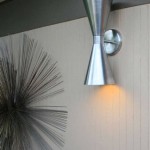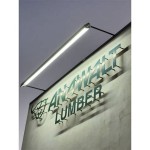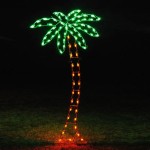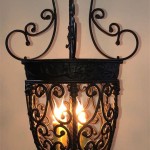Guide to Wire Outdoor Lights
Outdoor lighting enhances the beauty and security of any property. Selecting the correct wiring for outdoor lighting installations is crucial for safety, longevity, and optimal performance. This guide provides comprehensive information about choosing and installing wiring for outdoor lights.
Understanding Wire Gauge
Wire gauge refers to the thickness of the wire. Lower gauge numbers indicate thicker wires. Thicker wires offer less resistance, enabling them to carry higher electrical currents safely. Using the incorrect wire gauge can lead to overheating, voltage drops, and potential fire hazards. Selecting the appropriate gauge depends on the total wattage of the lights and the distance from the power source.
Common Wire Types for Outdoor Lighting
Several wire types are suitable for outdoor lighting applications. Each type offers specific benefits and drawbacks, making it essential to choose the correct type based on the installation environment and requirements.
1. THWN Wire
Thermoplastic High Heat-resistant Water-resistant Nylon-coated (THWN) wire is a common choice for outdoor wiring. Its insulation provides excellent resistance to heat, moisture, and abrasion, making it suitable for various outdoor conditions.
2. UF-B Cable
Underground Feeder (UF-B) cable is designed specifically for direct burial in the ground. Its robust construction and waterproof jacket protect it from moisture and damage, making it ideal for landscaping lights and other underground installations.
3. Low-Voltage Landscape Lighting Wire
Low-voltage landscape lighting systems typically operate at 12 volts. This requires specialized wiring designed for lower voltage applications. This wire usually comes in direct burial forms and features multiple insulated conductors within a single jacket.
Determining the Correct Wire Gauge
Calculating the correct wire gauge involves considering the wattage of the lights and the distance from the power source. Online wire gauge calculators can simplify this process. These calculators often require inputting the total wattage of the lights, the distance to the power source, and the voltage of the system. The calculator will then determine the appropriate wire gauge to ensure safe and efficient operation.
Wiring Techniques for Outdoor Lighting
Employing proper wiring techniques is vital for a safe and reliable outdoor lighting system. Several methods are commonly used, each with its advantages.
1. Direct Burial Wiring
Direct burial wiring involves burying UF-B cable directly in the ground. This method is common for landscape lighting, providing a concealed and aesthetically pleasing installation. Ensure the cable is buried at the appropriate depth, typically 18 to 24 inches, to protect it from damage.
2. Conduit Wiring
Conduit wiring involves running wires through protective conduits. This method offers excellent protection against physical damage and environmental factors. PVC conduit is commonly used for outdoor applications due to its durability and resistance to moisture.
3. Wiring Through Existing Structures
Wiring can be run through existing structures, such as walls or fences. When using this method, ensure the wiring is properly protected and secured to prevent damage and ensure safety.
Essential Safety Considerations
Safety is paramount when working with electrical wiring. Adhering to safety precautions is essential to prevent accidents and ensure the long-term reliability of the lighting system.
1. GFCI Protection
Ground Fault Circuit Interrupter (GFCI) protection is crucial for outdoor circuits. GFCI outlets or breakers quickly interrupt the flow of electricity in the event of a ground fault, protecting against electric shock.
2. Proper Grounding
Proper grounding is essential for preventing electrical hazards. All outdoor lighting fixtures and wiring should be correctly grounded to provide a safe path for stray electrical currents.
3. Weatherproof Connections
All connections should be made using weatherproof connectors designed for outdoor use. These connectors prevent moisture from entering the connections and causing corrosion or short circuits.
4. Consult Local Codes
Always consult local electrical codes and regulations before beginning any outdoor wiring project. Adhering to local codes ensures a safe and compliant installation.
Selecting the Right Fixtures and Bulbs
Choosing appropriate fixtures and bulbs contributes significantly to the effectiveness and efficiency of the outdoor lighting system.
1. LED Bulbs
Light-emitting diode (LED) bulbs offer significant energy savings compared to traditional incandescent bulbs. Their long lifespan and durability make them a cost-effective choice for outdoor lighting.
2. Weatherproof Fixtures
Selecting weatherproof fixtures ensures the longevity and reliability of the lighting system. Look for fixtures with appropriate ingress protection (IP) ratings to ensure they can withstand the elements.
3. Dark Sky Compliance
Consider using dark-sky compliant fixtures to minimize light pollution. These fixtures direct light downward, reducing glare and preserving the night sky.
Planning Your Outdoor Lighting Layout
Carefully planning the layout of the lighting system is essential for achieving the desired aesthetic and functional results.
1. Identify Lighting Needs
Determine the specific areas that require illumination. Consider the purpose of the lighting, such as security, ambiance, or highlighting landscape features.
2. Spacing and Placement
Proper spacing and placement of fixtures ensure even illumination and minimize shadows. Consider the beam angle and light output of the fixtures when determining their spacing.
By understanding these aspects of wiring outdoor lights, individuals can create safe, functional, and aesthetically pleasing outdoor lighting systems that enhance their properties for years to come. Remember, if any uncertainty exists regarding electrical work, consulting a qualified electrician is highly recommended.
How To Hang Outdoor String Lights Resource Article By Partylights Com

50 Guide Wire For String Lights American Party

How To Hang Patio String Lights Blue I Style

30m Guide Wire Pvc Coated Stainless Steel Heavy Duty Hanging Kit Lighting Legends

Using A Cable To Hang String Lights Concord Carpenter

How To Hang Patio Lights Juggling Act Mama

How To Hang Patio String Lights Blue I Style

Blika Globe String Light Suspension Kit Outdoor Guide Wire 170 Chimiya

48 Ft Outdoor String Light Hanging Suspension Kit With Coated Metal Guide Wire For Easy Installation Tools And Accessories Included Com

String Light Hanging Kit Guide Wire For Outdoor Lights Vinyl Coated Rope Cable Include 182fts 304 Stainless Steel Turnbuckle And Hooks Com
Related Posts







